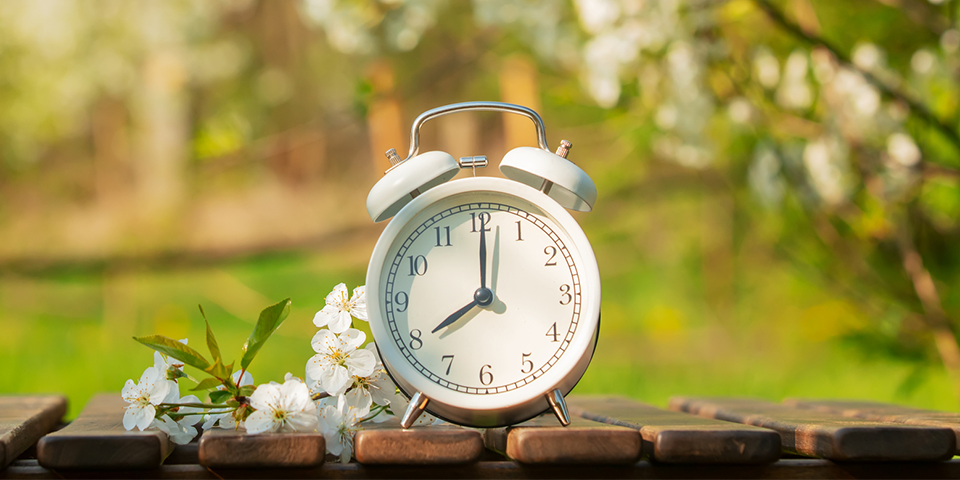For many of us, Daylight Saving Time marks a shift to better things: longer days… warmer nights… emptier gyms. But while moving the clock forward prepares us for spring, the resulting lost hour of sleep can wreak havoc on your regimen.
Check out our 10 expert-approved transition tips on how to adjust to Daylight Saving Time.
1. Reset Your Evening Routine
“Start going to bed and getting up 15 to 30 minutes earlier for two to three nights before Daylight Saving Time,” says Morgan Bettini, MS, RDN, LD/N.
Bettini believes that an evening routine prepares the body for a good night’s rest. Here is a sample routine that she recommends:
- Dim the lights.
- Lay your clothes out for the next day.
- Do some easy stretches.
- Read to put yourself in the mood for sleep.
2. Nap Freely

Sleep when you’re tired so that you aren’t catching up on yesterday’s work. A nap can positively impact your mental sharpness and emotional well-being.
Studies show there’s an increase in car accidents following the Daylight Saving time change due to fatigue. Instead of pushing through a long day, take a break and catch some z’s before driving anywhere.
3. Regulate Caffeine Intake
Coffee, sodas, and energy drinks are popular sources of caffeine, which is known to affect your sleep schedule. Functional nutritionist Jessica Tate, CNC, recommends the following ways to keep your caffeine intake in check around the time change:
- Cut caffeine after 2:00 p.m.
- Limit coffee consumption to one cup per day.
- Consider drinking green tea, matcha tea, and herbal tea.
4. Meal Prep

Cooking is one of the last things we want to do when we’re tired from the time change. Meal prep makes eating a cinch.
“Start meal prepping with simple steps, like bringing snacks to work or roasting a large pan of broccoli to eat for a couple of days. You don’t have to prep these elaborate meals to still soak in the benefit of a little advanced planning,” says Bettini.
5. Resist Cyberloafing
“People are more tired and less focused because the kind of light our phones emit messes with our circadian rhythms before bedtime,” says Tate. “While certain sleep apps and supplements can help people get into a restful state, they’re simply Band-Aids for a deeper issue happening internally.”
Studies show that our circadian rhythm is the result of physical, mental, and behavioral changes that follow a daily cycle. When we mess with that rhythm with poor sleep hygiene, we can throw off our body’s biological clock.
“The body was innately designed to fall asleep naturally. So, if you have trouble with sleeping, be sure to talk with a holistic healthcare provider to help you get to the root cause of the issue,” Tate says.
6. Curb Daylight Cravings

Daylight saving may adversely affect appetite, resulting in unwanted cravings. Research suggests that sleep deprivation triggers the reward center in our brains, compelling us to consume more calories than are warranted by those extra waking hours.
To curb cravings, Tate suggests limiting carbohydrates and eating more healthy fats, which will sustain your body longer. Some examples of fats Tate recommends include:
- Avocado (considered one of the healthiest foods on the planet for its well-rounded nutritional profile).
- Fatty fish (choose a wild-caught white fish for higher nutrition and fewer toxins).
- Nut and seed butters (any nut or seed works; choose one without added oils or sugars).
- Pasture-raised eggs (the whole egg is necessary for essential nutrients for the brain and overall system).
7. Keep Hydrated (No, Really)
“Our bodies are mostly water, so it makes sense that we need a lot of it, and on a regular basis,” says Bettini. “Otherwise, it can decrease our blood pressure and make us feel sleepy,” further compounding existing time change-related exhaustion.
By the time you’re thirsty, you’re already dehydrated. So drink ample water after the time change to get through your to-do list.
“Everyone’s water needs are different, but a good goal is 8 to 10 cups per day for most people,” says Bettini. “If someone isn’t used to this amount, it’s important to adjust slowly and over time so the body can get used to it.”
Another good method to measure your water intake is to try for half your body weight in ounces daily. If you weigh 150 pounds, that means you should try to drink 75 ounces of water every day.
8. Recharge With a Morning Workout

Lack of sleep following Daylight Saving Time can mess with your dopamine levels. Combat exhaustion and get a happiness boost by sticking to a morning workout routine (even when it’s still dark outside!).
“Exertion of energy first thing in the morning can wake you up, make you feel better, and gives you a dopamine release, ” says Wayne Stewart, NASM-CPT, CYT. “The dopamine can help you focus, and relieves stress brought on by changes to your schedule.”
Stewart’s go-to morning workout is high-intensity intervals (after a 10- to 15-minute warm-up). But even just challenging yourself with a few sets of a total-body exercises such as the burpee or bear crawl will do the trick.
Morning Meltdown 100 with BODi Super Trainer Jericho McMatthews can help you start your day with a 20- to 30-minute workout that’ll make you feel stronger, more accomplished, and less stressed. In each workout, you’ll get a mix of HIIT, resistance training, active recovery, and mobility so you have enough variety to prevent plateaus and keep having fun.
9. Try Myofascial Massage
Sudden onset stress brought on by disruptions to your routine — like a change in sleep pattern — can create muscle tension. Foam rolling can ease that tension by massaging and increasing blood flow to your muscle and fascia (connective tissue).
“Foam rolling is essential for healthy functioning muscles to release tension from strain or stress placed on the body,” Stewart says. “It allows the fascia within the body to be manually manipulated.”
Stewart likes to use the foam roller on these areas of the body:
- The upper leg (hamstrings and quads) and lower leg (calves) — avoid the knee.
- Upper back and shoulders because those areas are usually tight from stress and lousy posture.
- Glutes, tension in which can lead to tight hips and more stress on your spine. Sit on the foam roller in a figure-four position, tilting onto the glute of your crossed leg and rolling back and forth. After several rolls, switch legs and repeat on your other side.
10. Get Outside!

Exposure to sunlight boosts serotonin levels and decreases mental health distress brought on by disruptions to your schedule. Time spent outdoors can also help your mood. “Nature is proven to be a calmer of the mind. It is refreshing physically, mentally, and physiologically,” says Tate.
“Step outside for even five minutes, take three deep breaths, and share one gratitude. You will walk into your office a happier human!”

